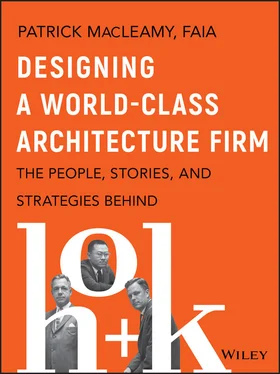Considerate Communication
The founders had a soft-spoken way of conveying what they wanted that I came to think of as “Suggest, Don't Tell.” They would make something sound like a request—“Why don't we do it this way”—but we all understood that it wasn't really a suggestion, it was an order. However, couched the way it was, it sure sounded a lot nicer. Maybe it was a midwestern characteristic, but in speaking like this, they were again demonstrating mutual respect for employees. When the leaders spoke, they didn't have to issue commands and edicts. Everyone knew what was expected. None of the founders had to raise his voice to be understood, and I never heard any of them shout in anger. This communication style trickled down to the staff in the way we addressed each other.
Another aspect of the founders' considerate communication was how they drew a line between public and private discussions. They praised excellent efforts and good teamwork publicly but corrected substandard work or lack of teamwork in private. If necessary, they let us know that we had disappointed them, but didn't harp on it, instead challenging us to do better next time. I have since heard a workplace saying for this: “If you're not happy with my work, tell me. If you are happy with my work, tell everybody.” Publicly humiliating people just makes them resentful. It doesn't help them improve, a concept many managers don't get.
When I was a young architect, I walked around with a copy of Ayn Rand's book The Fountainhead , in which the main character Howard Roark had great personal integrity—and was an architect! After much sacrifice, he ultimately achieved success and fame through the patronage of a powerful newspaper owner. I had also learned about the patronage system used during the Renaissance, when wealthy clients like the Medici family supported artists like Michelangelo. Even though HOK was my employer, I began to think of the firm as my patron, nurturing me in my career, so that I, in turn, could take care of HOK clients. This is more than nice—it's smart—since employees are the most important asset of any service business.
A good example of HOK taking care of its people occurred about a year after I joined the firm. I was working at my desk when Hellmuth came through the design department followed by one of the accountants, pushing a little cart filled with envelopes. Hellmuth gave each person an envelope and said a few words. When Hellmuth reached my desk, he retrieved an envelope from the cart and gave it to me. It was personalized with my name. He shook my hand and said, “Here's a gift of appreciation for your hard work. Thank you.” The envelope contained a bonus check made out to me, and I was thrilled! The founders understood that treating people well and giving them opportunities to grow were two keys to building a great firm.
Hellmuth also had a more down-home way of thanking the staff. Every summer, he invited us to his farm in the Ozark Mountains of southern Missouri for a weekend of fun. The land was not suitable for traditional farming as the soil is thin and rocky with many caves, springs, and streams. Hellmuth's farm was called “The Sinks” for the stream that ran alongside the farmhouse before “sinking” directly into a hill nearby, forming a cave.
When I arrived in my VW Beetle on a typically hot, muggy Missouri summer day, HOK men were everywhere. Yes, it was mostly men then. In fact, Hellmuth called us “my boys.” Employees were sitting in the shade, lounging on the grass or swimming in the stream. Several had climbed on a ledge and were cannonballing into the stream, spraying everyone nearby with cool Ozark water. Good, clean fun was the order of the day.
When evening came, a station wagon pulled up and the tailgate opened to reveal every type of soft drink, beer, “adult beverage,” and mixer imaginable. Everyone had a drink or two and told HOK stories. Dinner was simple: steak and salad. One group made salads, but Hellmuth grilled all the steaks himself. He said, “A steak isn't good enough for my boys if it doesn't hang off both sides of the plate,” so these were enormous slabs of beef! Everyone lined up to get a plate, loaded up some salad, then stopped at the grill to get a steak from Hellmuth.
When it was my turn, he looked me in the eye and said, “Thank you, Patrick,” and he meant it sincerely. This was another way Hellmuth personally acknowledged each person's hard work. Everyone sat at picnic tables, or on rocks, or at big tables indoors. It was a great time, with lots of laughter. When it came time to sleep, everyone found a flat spot, took out a sleeping bag or an air mattress, and slept right where they were.
On Sunday morning, Hellmuth rang an old-fashioned school bell to get everyone moving. He organized groups to go to church, having mapped out directions to a church for every denomination. “It's okay to have a good time Saturday night, but by damn you're going to go to church on Sunday,” he insisted. Hellmuth established a wholesome code of conduct by his example. In fact, when an opportunity came to design the St. Louis Playboy Club, he turned it down. It didn't fit in with HOK culture.
These weekends—Hellmuth opening his home and inviting everyone in for a feast— were one more embodiment of HOK culture. The time spent swimming, horsing around, eating, and laughing helped everyone feel like family. He gave us a place to bond. Actually, he gave us two.
HOK's annual party was held in Hellmuth's backyard in St. Louis, where he also welcomed our spouses and friends. His mother lived next door and the two backyards were connected, so he used both for the party. A committee decorated the yard, and arranged live music, so it was a noisy event. People gave little speeches, and someone was usually pushed into the pool. Every year one of the neighbors would complain about the noise and end up calling the police, but Hellmuth always invited the officers in and gave them dessert. The police would warn the crowd to hold the noise level down, then depart.
These occasions were very personal and permeated with the wholesomeness of the Midwest. After only a short time at the firm, I felt like part of something larger—a team and a family. One of the biggest challenges HOK would face in the future was how to maintain that family culture when the firm was spread all over the country—and then the world.
One of the biggest challenges HOK would face in the future was how to maintain that family culture when the firm was spread all over …
Storytelling was another important part of HOK culture and can strengthen any company. Just as tribes have told existential stories around the fire for centuries, HOK people told stories as a way of connecting. The senior staff especially loved to tell humorous stories about clients and projects. King Graf, Hellmuth's senior assistant, was one of my favorite storytellers. He told and retold a tale about traveling with Hellmuth to an interview for a new grade school in a little town in Missouri. The interview was held in one of the classrooms. As they approached the classroom door, they heard the school officials interviewing another team, so they sat in the hallway on a couple of tiny chairs, holding their giant portfolios and waiting with their knees up under their chins.
The HOK interview was scheduled for 7:00 p.m. Hellmuth was not a patient person and kept checking his watch. At 7:00 p.m. the other team was still in the classroom, so he went to the door and knocked. Conversation in the classroom stopped for a second, then resumed. Hellmuth waited a moment for someone to come to the door, and then —Blam! Blam! Blam!—pounded on the door. A man from the school district cracked the door open and Hellmuth said, “Our time started five minutes ago.” “Well, please wait,” the man replied, only to be pushed out of the way. Hellmuth suspected the project was wired for another firm, so he strode into the room and declared, “I'm George Hellmuth of HOK and I'm here for an interview. I know we're the best, you know we're the best, so just give us the damned job!” Then he turned and left. At the end of King's story someone always asked if HOK got the job. King would smile and say, “Hellmuth was right—we didn't win that one!”
Читать дальше












